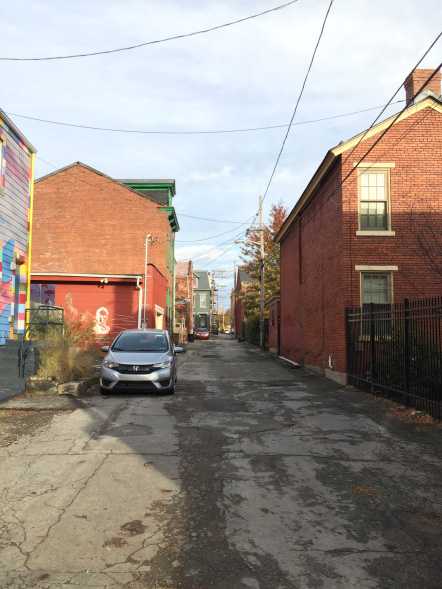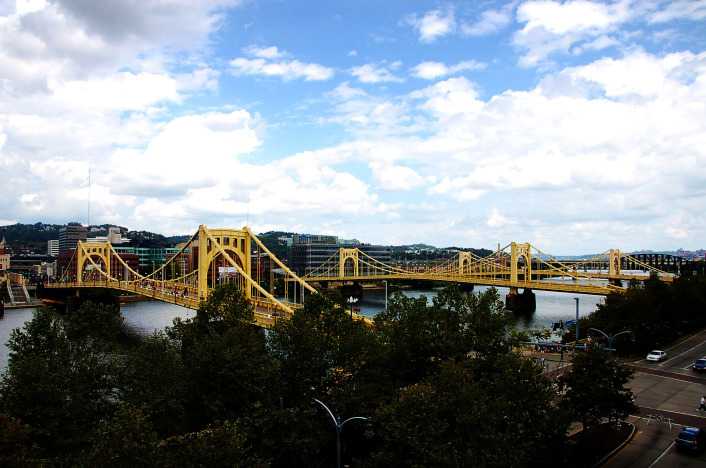Secret Pittsburgh
Serendipity and Sanctuary
By Daniel Lampmann
One afternoon, a man with a calloused right hand and coarse voice gave a talk in Pittsburgh. This man’s name was Salman Rushdie and the Iranian government wanted him dead. Why? Iran wanted him dead because of a novel he wrote, The Satanic Verses. In his novel, Rushdie used magical realism and contemporary events to frame a story around Islam and the prophet Muhammad. The Supreme Leader of Iran, Ayatollah Ruhollah Khomeini, believe Rushdie to be a threat to “his” Iran.
“From the beginning men used God to justify the unjustifiable.”
- Salman Rushdie, The Satanic Verses
With the prospect of death constant and the ability to fight the injustice impossible, Salman Rushdie found himself protected by cities of refuge. Now many years after his persecution, he stands in front of a crowd to speak about his experiences. In this talk he mentioned the network of European cities that are sanctuaries for exiled and endangered writers. This network was made by ICORN, which is an independent organization of cities and regions offering shelter to writers and artists at risk. They strive for the advancement of freedom of expression, to defend democratic values, and to promote international solidarity. He came to speak in Pittsburgh, the City of Bridges, we’re 446 total bridges connect roads and those roads connect people. With serendipity on their side, two important individuals were in the crowd, Henry Reese and Diane Samuels. These two looked at each other. What if we could help? Pittsburgh is ready. We are ready. Can Pittsburgh join this network? Six years later they received a response, yes.
A City of Bridges
Pittsburgh is a fickle city. It has developed from a trade post on the Ohio River, to a city producing more steel than clean lungs, to a cultural center with artistic intent. The City of Asylum is one of the most important additions to the city of Pittsburgh. The City of Asylum is a sanctuary for writers who are persecuted in their home country for their works. They come to it seeking refuge, but Pittsburgh gives them more. The City of Asylum focuses greatly on how to engage differing groups from around the city through the power of creative expression. However this is not a new idea, Pittsburgh has a history of inclusivity of differing groups. After all, Pittsburgh is the City of Bridges.
For instance, the Irene Kaufmann Settlement in the Hill District in 1909 was a Jewish community center that was open to all races, ethnicities, and religions. The settlement offered specialized educational courses to teach new immigrant English and skills to find a job (Pittsburgh: the real City of Brotherly Love by Dan Lampmann). The neighborhood of Oakland has historically been an ethnically diverse area. In a 1977 atlas of the area it was said, “Italians, Blacks, Jews, Syrians, and Poles have long been permanent residents…Approximately 88 foreign countries are represented in the student body of the University of Pittsburgh.” (An Atlas of the Oakland Neighborhood of Pittsburgh 1977). Even today, December 17, 2015, there are 165 days until Pittsburgh’s Pride Festival for LGBTQIA+ community. Pittsburgh’s bridges connect us all to one another through intertwined roads, but not all roads are always open. There are always a few bridges that are shut down, dilapidated, or structurally unsound. These need architects to build them up.
Like any city, Pittsburgh is not without its faults and tragedies. The Hill District riots from April 5th, 1968 to April 12th in the wake of the assassination of Martin Luther King, Jr. or the 2015 shooting of a Muslim taxi driver due to religious tension show that Pittsburgh is still striving to be better. These are the bridges that are currently decaying and shut down. Over time the things holding the bridges together have fallen away and left the bridges in need of support. How can we rebuild? What can we do?
The City of Asylum can and is rebuilding those damaged bridges with the easiest and most difficult action: connecting people through a social sanctuary.
Social Sanctuary
What does it mean to be a sanctuary? A sanctuary could be an oasis with palm trees surrounded by desert, a coffee shop table that tilts when you elbows hit it as you lean forward, what about four homes and a few writers. In a city, a sanctuary is where all citizens can come and be welcomed with open arms not pointing fingers. Sanctuaries are meant to stay compact, but in this massive world, what if a city could be a sanctuary for an entire country? First, there must be a catalyst and the City of Asylum is just that in Pittsburgh.
The City of Asylum is the diamond in the rough. It was brought to the city in 2004. Since that time it has built a following of Pittsburghers who want to see it flourish. As a refuge of writers, it must provide a living stipend, medical benefits, and the house for them to live. The writers must do their part to contribute to the community by taking part in events. As the writers take part in this, they build relationships with their community members and friendships are born. Now think about how this can influence a city. Pittsburgh can take notes on the way that the City of Asylum functions to be that beacon of hope and color in an otherwise semi-somber city. It is a social sanctuary where endangered writers can go, but also where those who have a natural curiosity of the new and different can seek out those things. In Philip Sheldrake’s paper titled Placing the Sacred: Transcendence and the City he said,
“Architects and planners will be genuinely ethical and spiritual forces in city-making, when they leave behind the temptation to become Olympian social engineers and empower citizens in their quest to articulate for themselves a common ethos that engages not only with sacred spaces in the city but with the sacredness of human life as whole.” (Map from 1872)
-Philip Sheldrake
Think about it, Pittsburgh is the City of Bridges. It connects people to people, but there are always bridges shut down and in need of rebuilding. City planners and architects must be the ones to rebuild the bridges with the new technology and information, and in doing so connecting those who weren’t before. The City of Asylum is an architect that is building a place of worship of a secular voice, the arts. Since 2004, it has had cross-cultural events and interaction. In 2014, they held book releases, public screenings, the choir performances by the Gold Tunes Choir, Lost and Found: Finding Refuge in Pittsburgh a play was performed, they held a Jazz Poetry Concert, and even the We Are the Rest of Change: Hip Hop Havana Style event was held there. City of Asylum is doing its part to build a social sanctuary for its writers in exile and for Pittsburghers. Asylum seekers are there to find a sanctuary to never have to look over their shoulders like Salman Rushdie. They are looking for a place to live where a community is there to find and welcome them. The City of Asylum’s placement on 400 Sampsonia Way, an alley, foster a close knit group that is based out of similar belief of freedom of expression, and this group continues to grow. It was started as a place to give exiled and endangered writers space to live free of persecution. It was a place for “the others” of the world who need help. It was started to give something to another, but it’s grown into something more. The City of Asylum is a beacon of hope for any global citizen to find sanctuary and community and as long as it remains one of Pittsburgh’s architects, the decaying bridges of the city, like prejudice and bigotry, will be rebuilt and become the beacon’s shining light.
My Sanctuary
It’s a brisk Friday in November. I should have worn a jacket. My sweatshirt isn’t enough. Strolling down a narrow corridor of trashcans and stoops I see four beautiful murals. They mark my arrival at my destination. Feeling isolated between the stones of brick and concrete slabs, I feel anxious, but not worried. How will he be? Will I be able to understand him? What can I ask him? None of those are answered before Yaghoub Yadali steps out of the former crack house, now monument of Burmese religious figures. Yaghoub is serene in posture with eyes made for appraising. He joins the group, and we find a place to congregate. He begins to read from his book, Rituals of Restlessness. He concludes after a few minutes and asks, “would you like to hear about my 41 days in Iranian prison?” I fold up my tongue and put it away because my words should not share the same space as his. He talks about his interrogation process. He talks about his background as a television producer. He talks about his time as a child reading, filming, and writing. He makes jokes and I laugh. He thanks us for listening. We applaud. He returns to his residence and continues to write.
That day, I spoke to a television producer and writer from Iran who was jailed for 41 days because of his novel. I spoke to him in a driveway in the Northside of Pittsburgh. He told jokes, smiled, and laughed. Have you ever been instantly leveled by someone? Yaghoub Yadali did that too me. He is only one of the writers to stay at the City of Asylum as a writer-in-residence. He has left now. He has moved on to a new program. I wish I had the chance to talk to him more. I wish I could know how he got through being in prison. I wish I knew how he continues to write even in the face of the government. I wish I knew these answers, and I’m sure you do too. Where can you talk to someone like Yaghoub? The City of Asylum.
Don’t you want to know who will be living there next?
“Arriving at each new city, the traveler finds again a past of his that he did not know he had: the foreignness of what you no longer are or no longer possess lies in wait for you in foreign, unpossessed places.”
-Italo Calvino, Invisible Cities
Works Cited
“About ICORN.” ICORN International Cities of Refuge Network. ICORN.org, n.d. Web. 14 Dec. 2015.
Calvino, Italo. Invisible Cities. San Diego: Hardcourt Brace Jovanovich, 1978. Print.
“City of Asylum | Giving Voice.” City of Asylum. Courage Media, 2014. Web. 12 Dec. 2015.
Fallows, Deborah. “Pittsburgh’s City of Asylum.” The Atlantic. Atlantic Media Company, 31 Oct. 2014.Web.12 Dec. 2015.
Fox, Randy. “Pittsburgh’s Hill District: The Death Of A Dream (PHOTOS).” The Huffington Post. TheHuffingtonPost.com, 15 Sept. 2012. Web. 12 Dec. 2015.
Grotstein, Lauri. “The Masonic Hall Will Soon Be Home to Alphabet City.” NEXTpittsburgh. NEXT Pittsburgh, 26 Jan. 2015. Web. 12 Dec. 2015.
Murtagh, Peter. “Rushdie in Hiding after Ayatollah’s Death Threat.” The Guardian. Guardian News and Media Limited, 15 Feb. 1989. Web. 12 Dec. 2015.
Lampmann, Daniel. Pittsburgh: The Real City of Brotherly Love. 2015. Essay.
“Pittsburgh Pride Homeage.” Pittsburgh Pride. Delta Foundation of Pittsburgh, n.d. Web. 12 Dec. 2015.
Rushdie, Salman. The Satanic Verses: A Novel. New York: Random House, 2008. Print.
“Salman Rushdie on Terrorism, Intellectual Freedom and the Patriot Act.” Democracy Now. Democracy Now, 10 Aug. 2004. Web. 12 Dec. 2015.
Sheldrake, Philip. “Placing the Sacred: Transcendence and the City.” Literature & Theology. 21.3 (2007): pg.243-258. Web. 12 Dec 2015.
Pittsburgh Neighborhood Atlas. An Atlas of the Oakland Neighborhood of Pittsburgh 1977. Pittsburgh: Pittsburgh Neighborhood Alliance 1977. Print.


![Pittsburgh in 1872. Sampsonia Way is the alley between Jackson Street and Taylor Avenue. Today, this map hasn't changed except for a few street names. Plate 77 [map]. 1872. 200. “G. M. Hopkins Company Maps, 1872-1940”, Historic Pittsburgh Site.](/static/89e169fd1112376f5df1c3172f922663/6827c/north-side-historic-map-pittsburgh.jpg)